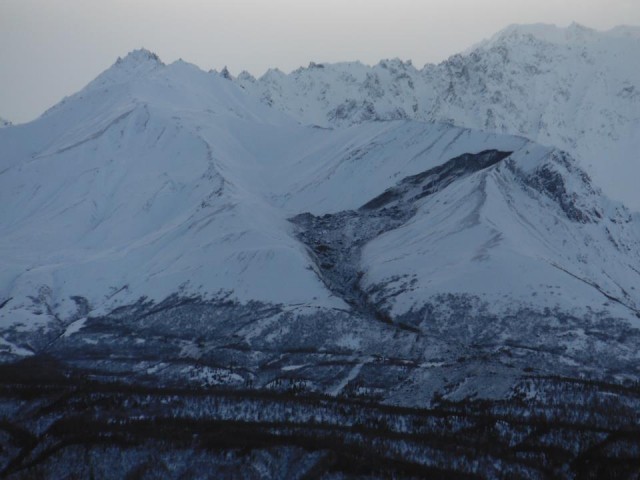22 March 2013
A very important new paper – detecting large landslides using seismic data
Posted by Dave Petley
![]() A paper was published today in the journal Science by Goran Ekstrom and Colin Stark in which they report on the use of the global seismic network to detect very large landslides in remote areas. Unfortunately the paper (Ekstrom and Stark 2013) is behind a pay wall, so I cannot provide a link to the actual text. Science have put out a press release about the work, and there are a couple of other news stories about it (here and here for example). For those that have access to the article, some of the landslides that they describe will be familiar. You will remember that last summer Colin provided data from his ongoing work with Goran that allowed us to unravel the mystery of the Seti River landslide in Nepal, and subsequently two rock avalanches in Alaska.
A paper was published today in the journal Science by Goran Ekstrom and Colin Stark in which they report on the use of the global seismic network to detect very large landslides in remote areas. Unfortunately the paper (Ekstrom and Stark 2013) is behind a pay wall, so I cannot provide a link to the actual text. Science have put out a press release about the work, and there are a couple of other news stories about it (here and here for example). For those that have access to the article, some of the landslides that they describe will be familiar. You will remember that last summer Colin provided data from his ongoing work with Goran that allowed us to unravel the mystery of the Seti River landslide in Nepal, and subsequently two rock avalanches in Alaska.
I was lucky enough to be asked to write the “perspectives” article (Petley 2013) that accompanies Ekstrom and Stark (2013), and this has also now been published in Science, so I have been lucky enough to read this paper ahead of its publication. I think that Goran and Colin have produced a really important piece of work. The essence is simple – very large landslides radiate seismic energy that is detectable using global seismic monitoring instruments. This of course was already known. What is novel about this work is that the authors have used an analytical model to analyse the seismic data to generate information about the landslide. At the moment this analysis uses a series of quite simple assumptions – I suspect that over the next few years this will become more sophisticated – but nonetheless it is very revealing. In particular it allows the generation of data on the size, direction of movement, travel distance and velocity of the landslide, as well as giving an indication of the location and of course the timing of the event.
So, to my mind this is important for three reasons. First, we now have a technique that allows large landslides to be automatically detected. Given that these tend to occur in very remote areas, they often go unreported. In fact, in the newspapers today there is a nice example of this (and thanks to Marten Geertsema for making me aware of this one). Alaska Public Media today is carrying the story of a large landslide near to the Matanuska Glacier “sometime in February”. They have this picture, which was taken by staff at Sheep Mountain Lodge:
The ability to build a catalogue of these events is very important; at last we will be able to work out just how frequent these events are.
Secondly, and perhaps most interestingly, the technique provides for the first time a systematic dataset that allows the dynamics of these landslides to be quantified. At the moment we do not understand how very large landslides move – they seem to go far further than one would normally expect, so it has been hypothesised that some mechanism acts that permits very long runout distances. We do not know what that mechanism might be, and indeed some argue that no such special mechanism is necessary. Being able to analyse the quantitative data that these landslides provide via the seismic network might help us to answer this question.
And thirdly, the technique allows us to validate our field mapping of landslides. The paper gives the example of a large rock avalanche detected using their technique in the Siachen area of northern Pakistan. Mappig of this landslide from the satellite imagery would indicate that it occurred in one or two large events. The seismic data indicates that it occurred as a much large number of discrete landslides over a few days. Knowing that will allow us to improve our field mapping, which in turn means that our analysis of the remains of ancient landslide deposits, and those triggered by earthquakes, will improve.
So, overall, this is probably the most important landslide paper of the last five years, and I am sure it will generate considerable discussion. I welcome your comments.
References
Ekstrom, G., & Stark, C. (2013). Simple Scaling of Catastrophic Landslide Dynamics Science, 339 (6126), 1416-1419 DOI: 10.1126/science.1232887
Petley, D. (2013). Characterizing Giant Landslides Science, 339 (6126), 1395-1396 DOI: 10.1126/science.1236165



 Dave Petley is the Vice-Chancellor of the University of Hull in the United Kingdom. His blog provides commentary and analysis of landslide events occurring worldwide, including the landslides themselves, latest research, and conferences and meetings.
Dave Petley is the Vice-Chancellor of the University of Hull in the United Kingdom. His blog provides commentary and analysis of landslide events occurring worldwide, including the landslides themselves, latest research, and conferences and meetings.